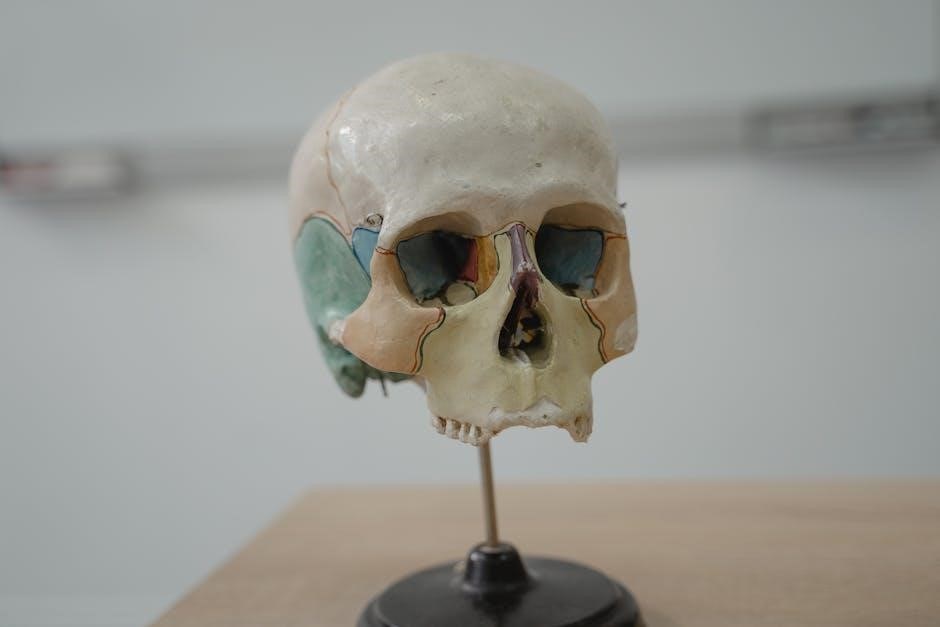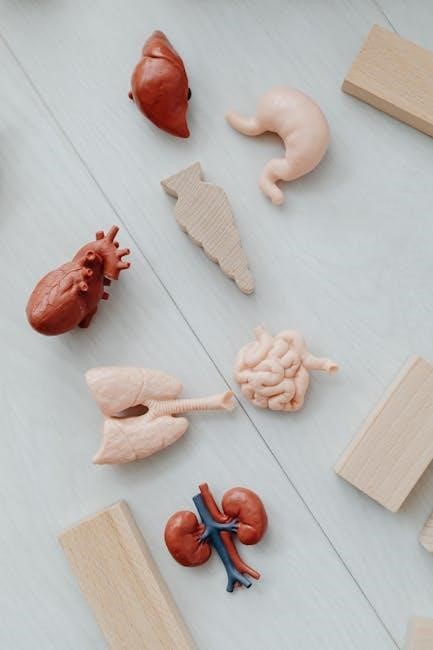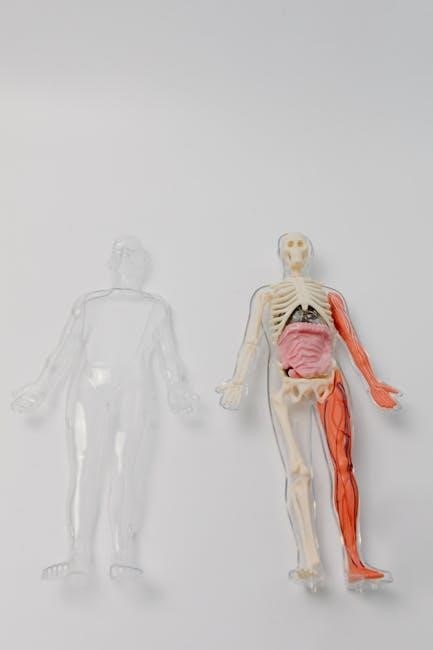Anatomy and Physiology Study Guide PDF: A Comprehensive Overview
Anatomy and Physiology study guides offer essential tools for mastering the complexities of the human body. They provide detailed advice, learning objectives, and practice questions, aiding in a comprehensive understanding. Utilizing study guides is key for success.
Anatomy, the study of the body’s structure, and physiology, the study of its functions, are fundamental to understanding healthcare. Delving into anatomy involves exploring the intricate details of organs, tissues, and cells, while physiology examines how these components work together to maintain life.
These fields are often studied together to provide a holistic view of the human body. Mastering these subjects can be achieved through dedicated study and the use of comprehensive study guides. Anatomy and physiology are critical for various healthcare professions, including nursing and medicine.
Effective study guides often break down complex concepts into manageable steps, incorporating visual aids and practice questions to enhance learning. This interdisciplinary approach is vital for students aiming to succeed in their healthcare studies.
The Importance of Study Guides in A&P
Study guides are indispensable tools for navigating the complexities of Anatomy and Physiology (A&P). They offer structured learning by consolidating key concepts and providing focused review material.
A&P study guides enhance understanding through various methods, including visual aids, practice questions, and detailed explanations. They help students identify and address their weak areas, ensuring comprehensive topic coverage. Effective study guides also offer unique study tips, helping students maximize their learning potential.
Moreover, these guides often include checklists to ensure all essential topics are covered, aiding in thorough exam preparation. They promote active learning, encouraging students to engage with the material rather than passively reading textbooks. By using study guides, students can build a solid foundation in A&P, crucial for success in healthcare fields.
Key Topics Covered in A&P Study Guides
A comprehensive A&P study guide delves into numerous critical topics essential for understanding the human body. These guides thoroughly cover foundational concepts such as cell structure, tissue types (epithelial, connective, muscle, and nervous), and the skeletal system.
The muscular system, including muscle physiology and major muscle groups, is also examined in detail. Furthermore, study guides explore the nervous system, encompassing the brain, spinal cord, and peripheral nerves, along with sensory and motor functions.
The cardiovascular system, covering the heart, blood vessels, and blood components, is another core area. Additionally, the respiratory, digestive, urinary, and endocrine systems are comprehensively addressed. Key topics include gas exchange, nutrient absorption, waste elimination, and hormone regulation. Reproductive system anatomy and physiology are also usually included, ensuring a complete overview of human body functions.

Essential Components of an Effective A&P Study Guide
Effective A&P study guides incorporate detailed learning objectives, practice questions with answer keys, and visual aids. These components enhance understanding and retention, facilitating successful exam preparation and knowledge consolidation.
Detailed Learning Objectives
Detailed learning objectives are a cornerstone of an effective Anatomy and Physiology (A&P) study guide. These objectives provide a clear roadmap, outlining what students should understand upon completing each section. By setting specific, measurable, achievable, relevant, and time-bound (SMART) goals, students can focus their study efforts effectively. Learning objectives should align with textbook content, lectures, and exam expectations, ensuring comprehensive coverage of essential topics. They serve as a checklist to track progress and identify areas needing further attention. Furthermore, detailed objectives promote active learning by encouraging students to engage with the material rather than passively reading. Ultimately, well-defined learning objectives enhance comprehension and improve performance in A&P courses. They ensure students grasp the core concepts.
Practice Questions and Answer Keys
A vital element of any effective Anatomy and Physiology (A&P) study guide is the inclusion of practice questions accompanied by detailed answer keys. These questions provide students with opportunities to test their understanding and apply learned concepts. Practice questions should cover a range of difficulty levels, from basic recall to complex problem-solving, mirroring the types of questions encountered on exams. Answer keys are essential, offering explanations for both correct and incorrect answers, fostering deeper learning. By working through these questions, students can identify knowledge gaps and reinforce their understanding of key topics. This active learning approach is far more effective than passive reading. Furthermore, regular practice builds confidence and reduces exam anxiety. Ultimately, practice questions and answer keys are indispensable for A&P success.
Visual Aids and Memory Tools
Anatomy and Physiology relies heavily on memorization, making visual aids and memory tools crucial components of an effective study guide. Diagrams, charts, and illustrations clarify complex anatomical structures and physiological processes, facilitating understanding and retention. Color-coding and labeling further enhance visual learning. Mnemonics, acronyms, and other memory tricks can help students recall key terms and concepts. Flashcards, both physical and digital, are excellent for spaced repetition, a proven method for long-term memory consolidation. Interactive models and simulations offer hands-on learning experiences. By incorporating these visual and mnemonic devices, study guides can transform dense information into more manageable and memorable content. Ultimately, these tools empower students to master the intricate details of A&P with greater ease and confidence. Consider incorporating personalized drawings or mind maps for even better retention.

Types of A&P Study Guides
A&P study guides come in various forms, including textbook companions, digital resources like flashcards and quizzes, and comprehensive review bundles. Each type caters to different learning styles and study preferences.
Textbook Companions
Textbook companions are specifically designed to supplement and reinforce the material presented in your primary Anatomy and Physiology textbook. These guides often include chapter summaries, detailed learning objectives, and a variety of practice questions that align directly with the textbook content.
They provide additional support for understanding complex concepts and help students consolidate their knowledge. Many textbook companions also offer unique study tips and visual memory aids to enhance learning. By using these companions effectively, students can test their knowledge and achieve a complete understanding of human anatomy.
Furthermore, these guides may include answer keys for self-assessment and identify areas needing further attention. They are invaluable tools for students seeking to master A&P.
Digital Study Guides (e.g., Flashcards, Quizzes)
Digital study guides, such as flashcards and quizzes, offer an interactive and engaging way to learn Anatomy and Physiology. These tools are often compatible with mobile devices and computers, providing flexibility for studying anytime, anywhere. Interactive flashcards can help memorize key terms and concepts.
Quizzes allow students to test their knowledge and identify areas where they need improvement. Many digital guides provide instant feedback, helping students understand their mistakes and learn from them. Some platforms offer bite-sized study guides, videos, and step-by-step practice problems, making learning more accessible and efficient.
These digital resources supplement traditional textbooks and enhance engagement with the material.
Comprehensive Review Bundles
Comprehensive review bundles for Anatomy and Physiology provide a complete package of study materials designed to help students thoroughly prepare for exams. These bundles often include a combination of study guides, practice tests, and visual aids, ensuring a well-rounded approach to learning.
Many bundles offer detailed topic coverage, breaking down complex concepts into manageable sections. They may also include checklists to ensure all key areas are covered during study sessions. Furthermore, these bundles frequently incorporate practice questions and answer keys to help students assess their understanding.
These resources are particularly valuable for students seeking a structured and organized approach to mastering Anatomy and Physiology. They offer a convenient way to access a variety of helpful materials in one place.

Utilizing A&P Study Guides for Exam Preparation
A&P study guides are invaluable tools for exam preparation, providing topic checklists, practice tests, and strategies for identifying weak areas. They ensure comprehensive coverage and focused study efforts.
Checklists for Topic Coverage
Topic coverage checklists are fundamental in anatomy and physiology study guides, acting as a roadmap to ensure no essential concept is overlooked. These checklists systematically outline all the subjects and sub-topics necessary for a thorough understanding of human anatomy. By using a checklist, students can verify that they have reviewed every area of the course, from basic cellular biology to complex organ systems. This structured approach aids in prioritizing study time and identifying gaps in knowledge. Furthermore, checklists often incorporate learning objectives, enabling students to self-assess their comprehension. Consistent use of topic coverage checklists promotes organized and efficient study habits. This method fosters confidence for exams by verifying complete material review. Checklists also facilitate collaborative learning, allowing study groups to track progress together.
Practice Tests and Mock Exams
Practice tests and mock exams are invaluable components of an effective anatomy and physiology study guide, simulating the actual exam environment and assessing comprehension. These resources provide a realistic evaluation of a student’s readiness. Practice tests cover all critical areas, from muscle structure to organ systems, enhancing recall and application of knowledge. Mock exams, mirroring the format and difficulty of the real test, help students manage time constraints and reduce anxiety. These exams include various question types, such as multiple choice and fill-in-the-blank, providing comprehensive practice. Answer keys with detailed explanations allow students to pinpoint areas needing improvement. Regular use of practice tests and mock exams builds confidence and refines study strategies. They are crucial for mastering anatomy and physiology. These tools foster a deeper understanding and better exam performance. They transform learning into an active, engaging process.
Identifying Weak Areas and Focusing Study Efforts
Effectively utilizing anatomy and physiology study guides involves identifying weak areas and focusing study efforts accordingly, ensuring efficient exam preparation. After completing practice tests or mock exams, students should carefully analyze their performance to pinpoint specific topics needing more attention. This targeted approach maximizes study time and improves comprehension. Tools like answer keys with detailed explanations are invaluable for understanding errors and reinforcing correct concepts. Students can create personalized study plans, allocating more time to challenging subjects. Flashcards, quizzes, and additional practice questions can further strengthen weak areas. Regularly revisiting and reinforcing these areas ensures a solid understanding. Focusing study efforts on identified weaknesses prevents gaps in knowledge and boosts confidence. This strategic approach streamlines learning, making study sessions productive and effective. By concentrating on areas needing improvement, students achieve a comprehensive grasp of anatomy and physiology, ultimately enhancing exam performance.

Resources for A&P Study Guides
A&P study guides are available through online marketplaces, publisher websites, and university libraries. These resources provide comprehensive materials, offering diverse options to enhance learning and exam preparation.
Online Marketplaces (e.g., Amazon, Etsy)
Online marketplaces like Amazon and Etsy offer a vast selection of Anatomy and Physiology study guides. These platforms provide access to a diverse range of materials, from textbook companions and digital flashcards to comprehensive review bundles. Students can find study guides tailored to specific textbooks or learning styles, often at competitive prices.
Amazon features study guides directly related to popular A&P textbooks, ensuring alignment with course content. Etsy, on the other hand, provides access to unique and handmade study aids, including visual aids and memory tools designed to enhance understanding. These online resources offer convenience and variety for students seeking effective A&P study materials. Shopping on these platforms allows for easy comparison of different study guides and access to customer reviews, aiding in making informed decisions.
Publisher Websites (e.g., Cengage, McGraw Hill)
Publisher websites such as Cengage and McGraw Hill are excellent resources for Anatomy and Physiology study guides. These sites often provide companion study guides specifically designed to align with their textbooks, ensuring comprehensive coverage of course material. These study guides frequently include detailed learning objectives, practice questions, and answer keys, aiding students in mastering key concepts.
Cengage offers a range of A&P resources, including interactive digital tools and study guides tailored to their popular textbooks. McGraw Hill provides access to study apps, videos, and step-by-step practice problems, enhancing the learning experience. Utilizing publisher websites ensures that students have access to accurate and relevant study materials directly from the source. These resources are often updated to reflect the latest editions of textbooks, providing the most current information available.
University and College Libraries
University and college libraries are invaluable resources for Anatomy and Physiology study guides. These libraries often house a wide range of textbooks, companion study guides, and comprehensive review bundles to support students in their A&P coursework. Libraries also provide access to digital resources, such as online study guides, flashcards, and quizzes, enhancing the learning experience.
Many libraries offer study guides specifically tailored to popular A&P textbooks, ensuring comprehensive coverage of key topics. Additionally, librarians can assist students in locating relevant materials and navigating library resources effectively. Students can also find practice tests and mock exams, crucial for exam preparation. Utilize library resources to identify weak areas and focus your study efforts efficiently. Libraries offer a quiet and conducive environment for focused studying.
